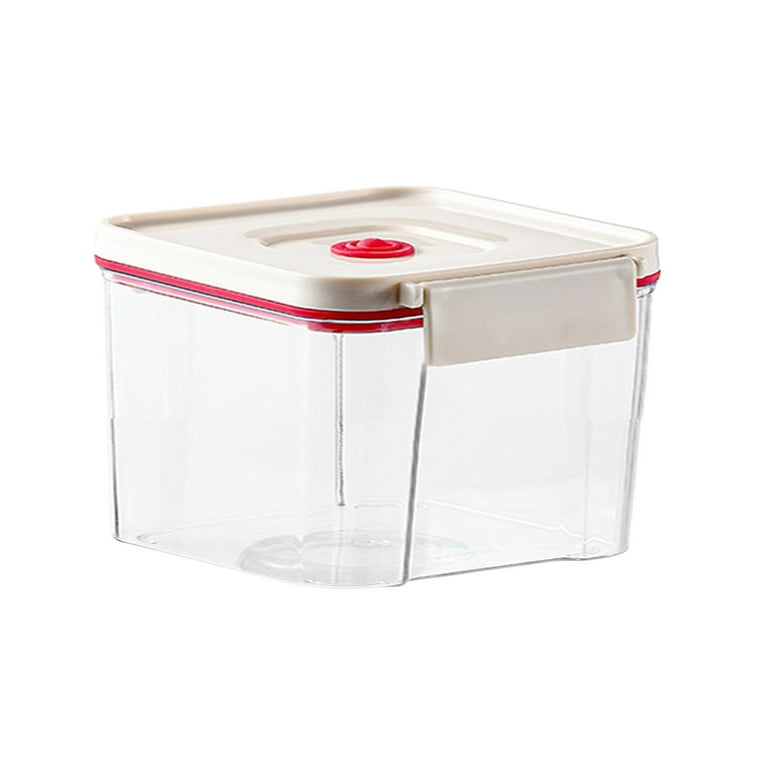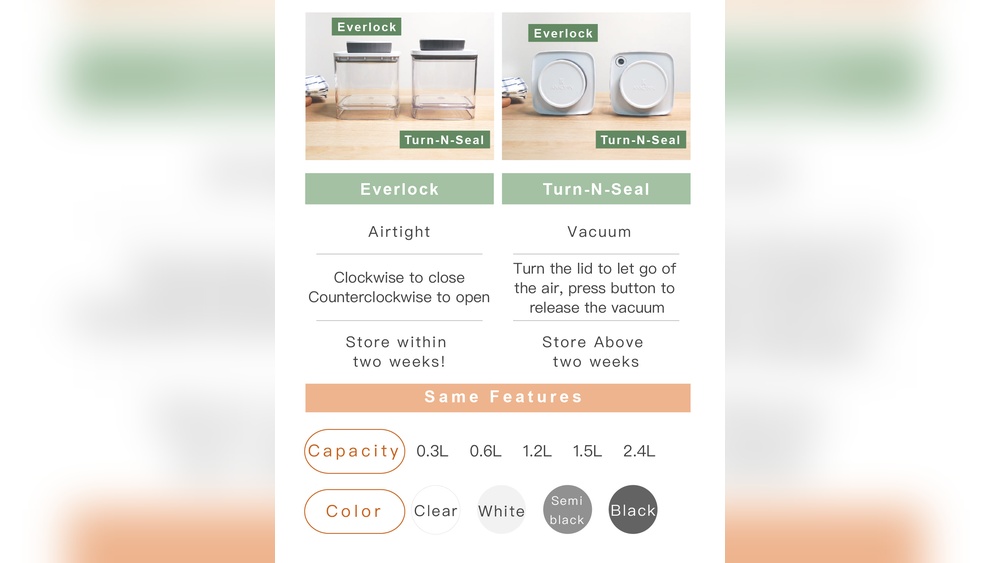When it comes to keeping your food fresh and your belongings protected, you might have wondered: what exactly sets airtight containers apart from vacuum-sealed ones? You probably know both aim to keep air out, but the way they do it—and the results they deliver—can be quite different.
Understanding this difference can save you money, reduce food waste, and help you choose the right storage solution for your needs. You’ll discover how airtight and vacuum-sealed containers work, their unique benefits, and which one is best for your everyday use.
Ready to unlock the secret to longer-lasting freshness? Let’s dive in.

Credit: www.walmart.com
Airtight Containers Basics
Airtight containers keep air from entering or leaving the container. They help maintain the freshness and quality of stored items. These containers are common in kitchens and for storing many other goods. Understanding their basics helps choose the right container for your needs.
Seal Mechanisms
Airtight containers use tight lids to stop air flow. Some lids have rubber or silicone gaskets. These gaskets fit around the rim to block air leaks. Other containers use locking clips or clamps for a stronger seal. The goal is to keep the container completely closed to air.
Common Materials
Many materials are used to make airtight containers. Glass containers are popular for their durability and non-reactive nature. Plastic containers are lightweight and affordable. Stainless steel containers offer strength and resistance to rust. Some containers use ceramic or metal for special uses. Each material has benefits for different storage needs.
Primary Uses
Airtight containers store food to keep it fresh longer. They prevent moisture and air from causing spoilage. Many people use them for dry goods like flour and sugar. These containers also hold leftovers and snacks safely. Besides food, they protect items like craft supplies and small tools. Airtight containers help reduce waste and save money.

Credit: www.amazon.com
Vacuum-sealed Containers Basics
Vacuum-sealed containers remove air from inside before sealing. This process extends food freshness and prevents spoilage. These containers create a vacuum environment that slows down bacteria growth and oxidation.
Understanding vacuum-sealed containers helps you choose the right storage for your needs. Their design and function differ from regular airtight containers.
How Vacuum Sealing Works
Vacuum sealing removes air from the container using a pump or machine. Once air is removed, the container is tightly sealed. This lack of air stops oxygen from reaching the food inside. Oxygen is a key factor in food spoilage. Without oxygen, mold and bacteria grow slowly or not at all.
Materials And Designs
Vacuum-sealed containers often use strong plastic or glass. These materials keep the vacuum intact and are safe for food. Some containers have special valves for air removal. Others work with vacuum sealing machines. Designs vary from jars to bags and boxes, depending on use.
Applications
Vacuum sealing suits food storage like meat, cheese, and vegetables. It also protects dry goods such as coffee and nuts. Vacuum-sealed containers help in sous vide cooking. They are useful for long-term storage in refrigerators and freezers. These containers reduce food waste and keep items fresh longer.
Air Removal Differences
Air removal plays a key role in how airtight and vacuum-sealed containers work. Both types limit air exposure but do so differently. Understanding these differences helps you choose the right container for your needs.
Airtight Vs Vacuum Environment
Airtight containers block air from entering or leaving the container. They rely on tight seals to trap the air already inside. This air remains but cannot escape or enter. Vacuum-sealed containers remove most or all air inside before sealing. This creates a low-pressure environment with little to no air. The vacuum slows down food spoilage by limiting air contact.
Impact On Oxygen Levels
Airtight containers keep oxygen levels stable inside. The oxygen trapped can still affect the contents over time. Vacuum-sealed containers reduce oxygen to near zero. Lower oxygen means less chance for bacteria and mold to grow. This extends the freshness and shelf life of food. Oxygen removal is the main reason vacuum sealing works better for long-term storage.
Food Preservation Benefits
Food preservation benefits play a key role in choosing the right storage container. Airtight and vacuum-sealed containers both help keep food fresh, but they do so in different ways. Understanding these benefits helps in selecting the best option for your needs.
Shelf Life Extension
Airtight containers limit air exposure, slowing down food spoilage. They keep moisture and odors inside, which helps food last longer. Vacuum-sealed containers remove air entirely. This stops oxidation and bacterial growth more effectively. As a result, vacuum-sealed foods often stay fresh for weeks or months beyond normal limits.
Prevention Of Spoilage
Spoilage happens due to air, moisture, and bacteria. Airtight containers reduce these risks by creating a tight seal. This slows mold and bacteria development. Vacuum sealing removes almost all air. This creates a near oxygen-free zone, preventing most spoilage causes. Foods stored this way stay safe and fresh much longer.
Freezer Burn Protection
Freezer burn happens when air touches frozen food. Airtight containers reduce air contact but do not remove air completely. Vacuum-sealed containers remove air around the food. This prevents ice crystals from forming on the surface. Vacuum sealing protects food texture and flavor better in the freezer.
Usage And Convenience
Understanding the usage and convenience of airtight and vacuum-sealed containers helps in choosing the right storage option. Both types keep food fresh but differ in handling and practicality. These factors affect daily use and storage efficiency in kitchens and homes.
Ease Of Use
Airtight containers are simple to use. Just close the lid firmly to seal air out. No extra tools are needed. Vacuum-sealed containers require a pump or machine to remove air. This step takes more time and effort. For quick storage, airtight containers offer faster access.
Storage Space Considerations
Airtight containers come in many sizes and shapes. They stack easily but may take more space due to their rigid lids. Vacuum-sealed containers often shrink the contents by removing air. This saves space in the fridge or pantry. However, vacuum machines need extra counter space.
Reusability
Airtight containers are durable and easy to clean. They can be reused many times without losing their seal. Vacuum-sealed bags or containers may wear out faster. Some bags are single-use, while others can be reused with care. Airtight containers offer more long-term value.
Cost And Accessibility
Cost and accessibility play a big role when choosing between airtight and vacuum-sealed containers. The price and how easy it is to buy them affect many buyers. Knowing these differences helps you pick the right option for your needs and budget.
Price Differences
Airtight containers usually cost less than vacuum-sealed ones. They have simpler designs without extra parts. Most airtight containers range from low to mid prices. Vacuum-sealed containers often come with pumps or machines. These parts make them more expensive. Prices can be higher depending on brand and features.
Choosing airtight containers can save money for basic storage needs. Vacuum-sealed containers may be worth the cost if you want longer food freshness. Both types offer good value but fit different budgets.
Availability In The Market
Airtight containers are widely available in many stores. You can find them in supermarkets, home goods shops, and online. Their simple design makes them easy to produce and stock. Vacuum-sealed containers are less common. You often find them in specialty stores or online shops. Some brands only sell through specific retailers.
The broad availability of airtight containers makes them easy to get quickly. Vacuum-sealed containers may require more searching or waiting for delivery. Accessibility depends on your location and shopping preferences.
Limitations And Drawbacks
Both airtight and vacuum-sealed containers help keep food fresh. Each type has limits that affect their use. Understanding these drawbacks helps choose the right container for your needs.
Potential Disadvantages Of Airtight Containers
Airtight containers may not remove all air inside. Some air can stay trapped, causing food to spoil faster. The seal can wear out over time, letting air leak in.
Many airtight containers rely on rubber or silicone gaskets. These gaskets can degrade or break, reducing effectiveness. Cleaning can be tricky, especially around the gasket.
Not all airtight containers keep moisture out completely. This can lead to soggy or stale food. They also do not stop bacteria growth as well as vacuum-sealed containers.
Challenges With Vacuum-sealed Containers
Vacuum sealing removes most air, but the process can be complex. It often requires special machines that cost extra money. Without the right equipment, the seal may not be perfect.
Some vacuum-sealed bags and containers are not reusable. This creates more waste and adds to expense. The plastic used may not be environmentally friendly.
Vacuum-sealed containers can crush delicate foods. The pressure from removing air may damage soft fruits or breads. Also, some foods need to breathe and do not store well in vacuum seals.

Credit: www.amazon.com
Choosing The Right Container
Choosing the right container matters for food storage. It affects freshness, taste, and shelf life. Not all containers work for every need. Understanding the difference between airtight and vacuum-sealed containers helps pick the best option.
Based On Food Type
Dry foods like rice and beans do well in airtight containers. They keep moisture and bugs out. Vacuum-sealed containers suit meats and cheeses better. Removing air stops bacteria and mold growth. Fresh fruits and vegetables need gentle storage. Airtight containers keep them crisp without crushing.
For Long-term Vs Short-term Storage
Short-term storage needs simple airtight containers. They keep food fresh for days or weeks. Vacuum-sealed containers work best for long-term storage. They remove nearly all air, slowing spoilage. Freezing vacuum-sealed bags extends food life. Choose container type based on how long you store food.
Environmental Impact
Airtight containers are often reusable and durable. Glass and stainless steel types last many years. Vacuum-sealed bags may be single-use or limited reuse. Plastic waste can increase with vacuum sealing. Consider containers that reduce waste and use eco-friendly materials. Reuse and recycle to lower environmental harm.
Frequently Asked Questions
What Is The Difference Between Airtight And Vacuum?
Airtight containers prevent air from entering or escaping by sealing tightly. Vacuum containers remove all air inside, creating a low-pressure environment. Both preserve freshness, but vacuum sealing offers longer protection by eliminating oxygen completely.
Are Vacuum Seal Containers Airtight?
Vacuum seal containers remove air to create a tight, airtight environment. This prevents oxygen exposure and preserves freshness effectively.
What Are The Disadvantages Of Vacuum Sealing?
Vacuum sealing can crush delicate foods and cause texture changes. It may trap anaerobic bacteria and requires special bags. It also increases upfront costs and limits flexibility in portion sizes.
What Is Considered An Airtight Container?
An airtight container has a tight-fitting lid with a seal or gasket that blocks air from entering or escaping. It preserves freshness and prevents spoilage effectively.
Conclusion
Choosing between airtight and vacuum-sealed containers depends on your needs. Airtight containers block outside air to keep food fresh. Vacuum-sealed containers remove air inside for longer preservation. Both help reduce spoilage and waste. Vacuum sealing offers stronger protection against bacteria and freezer burn.
Airtight containers are easier to use and great for everyday storage. Understanding these differences helps you store food better. Pick the right container to keep your food fresh longer and save money. Simple steps make a big difference in food storage quality.

